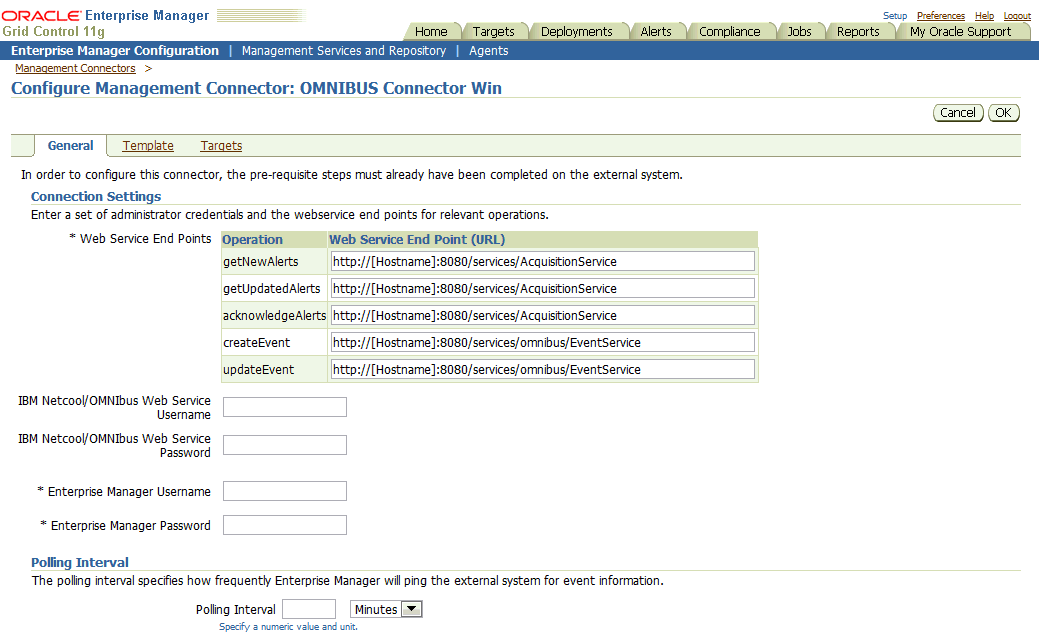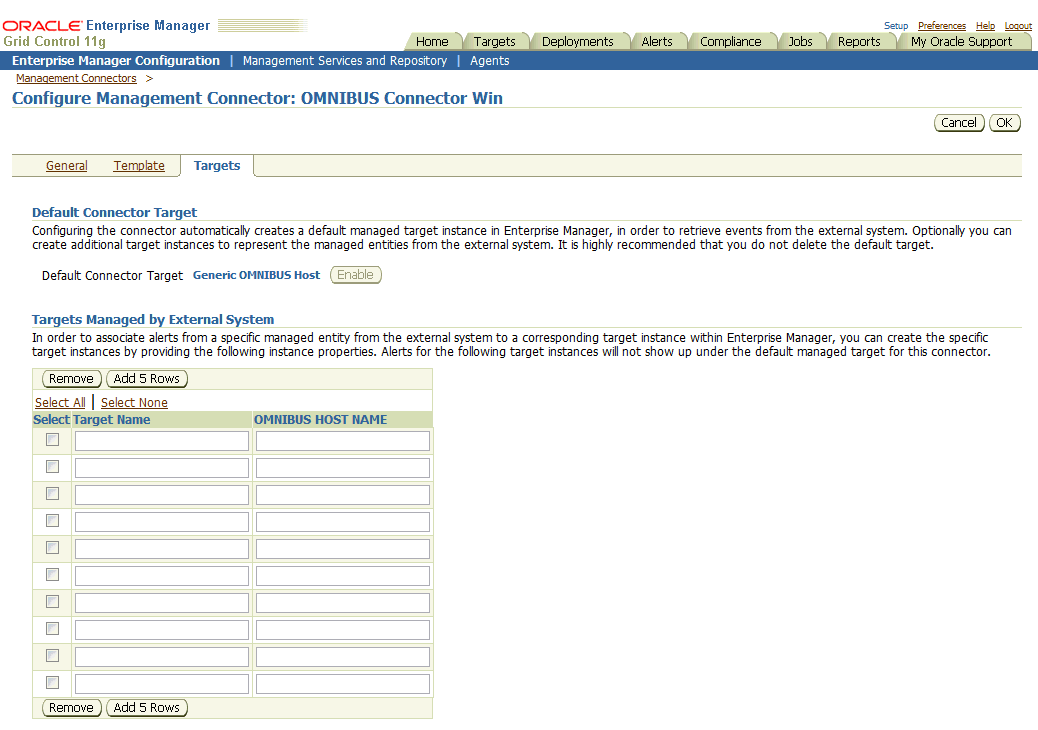3 Configuring the Connector
This chapter provides procedures to configure the two sub-pages of the main Configure Management Connector page, then explains how to perform other tasks to complete the configuration process.
This chapter discusses the following topics:
-
Sending Oracle Enterprise Manager Alerts to IBM Netcool/OMNIbus
-
Sending IBM Netcool/OMNIbus Events to Oracle Enterprise Manager
3.1 Configuring the General Page
To configure the General page:
-
From the Management Connectors page, select the Netcool/OMNIbus Connector and click the Configure icon. By default, the General sub-page of the Configure Management Connector page appears, as shown in Figure 3-1.
-
Update the URLs for each of the Web Service End Point operations as described below.
Operation Descriptions
The Netcool/OMNIbus connector uses the following operations (web methods) to exchange data with the Netcool/OMNIbus Web Service:
-
getNewAlerts— Creates alerts in Oracle Enterprise Manager based on events that originate in IBM Netcool/OMNIbus. Oracle Enterprise Manager uses this operation when polling for events in IBM Netcool/OMNIbus. -
getUpdatedAlerts— Updates alerts in Oracle Enterprise Manager based on events that originate from IBM Netcool/OMNIbus. Oracle Enterprise Manager uses this operation when polling for events from IBM Netcool/OMNIbus. -
acknowledgeAlerts— Acknowledges the alerts after Oracle Enterprise Manager has processed them. Oracle Enterprise Manager uses this operation when polling for events in IBM Netcool/OMNIbus. -
createEvent— Generates events in IBM Netcool/OMNIbus based on alerts that originate in Oracle Enterprise Manager. Oracle Enterprise Manager invokes this operation when it forwards a new alert to Netcool/OMNIbus. -
updateEvent— Updates events in IBM Netcool/OMNIbus based on alerts that originate in Oracle Enterprise Manager. Oracle Enterprise Manager invokes this operation when it forwards a new alert to Netcool/OMNIbus.
URL Types
The connector uses two different URLs for operations. One URL polls data out of IBM Netcool/OMNIbus (
getNewAlerts,getUpdatedAlerts, andacknowledgeAlerts), and defaults to the following value:http://[Hostname]:8080/services/AcquisitionService
The other URL pushes data into IBM Netcool/OMNIbus (
createEventandupdateEvent), and defaults to the following value:http://[Hostname]:8080/services/omnibus/EventService
You need to make the following changes to each of the default URLs:
-
Replace
[Hostname]in the URL with the hostname or IP address of the system where the Netcool/OMNIbus Web Service is installed. -
If necessary, change the port to the port on which the web services are running. For example, the default port for HTTP is 8080 and the default port for HTTPS is 8443.
-
If the Netcool/OMNIbus Web Service was configured to use the HTTPS protocol, change http to https at the beginning of each web service URL.
If you are using HTTPS as the protocol, you must also include the Netcool/OMNIbus web service certificate in Oracle Wallet Manager as described in Adding Signed Certificates to Enterprise Manager.
-
-
Enter the user name and password you specified when you installed the Netcool/OMNIbus web service, which is discussed in steps 9 and 10 of Installing the Web Service on Unix and section steps 9 and 10 of Installing the Web Service on Windows.
The Netcool/OMNIbus web service installer prompts for the user name and password that should be supplied when accessing the Netcool/OMNIbus web service. It provides default values if you do not provide a response.
-
Enter the user name and password of the Oracle Enterprise Manager account.
Note:
The Enterprise Manager credentials are not used directly by the connector. The connector credentials are required by the connector framework. -
Optionally enter a polling interval to specify how often Oracle Enterprise Manager should poll the IBM Netcool/OMNIbus web service for new or updated events to process. The poll interval defaults to 5 minutes if not specified.
-
Click OK to save your configuration changes.
3.2 Configuring the Targets Page
Whenever an IBM Netcool/OMNIbus event is translated into an Oracle Enterprise Manager alert, the IBM Netcool/OMNIbus event host name determines the target-type instance associated with the alert in Oracle Enterprise Manager. If a target instance that matches the event host name is not found, the default target instance of generic_omnibus_host is used for the alert.
To add proxy targets in Oracle Enterprise Manager:
-
From the Configure Management Connector page, click the Targets link to display the Targets page, as shown in Figure 3-2.
-
Provide a target name. The Target Name field is set to the host name specified in the Netcool/OMNIbus event and must exactly match the name.
-
Provide the Netcool/OMNIbus host name in the OMNIBUS HOST NAME field. This field must be set to the same value as the Target Name field.
-
Repeat this process for as many target instances as desired.
-
Click OK to save your configuration changes.
3.3 Testing the IBM Netcool/OMNIbus Connector
-
Log in to the Oracle Enterprise Manager console by entering a user name with a "Super Administrator" role, entering the appropriate password, then clicking Login.
-
Click the Setup link at the top right part of the window. The Overview of Setup page appears.
-
Click the Management Connectors link on the left side of the window. The Management Connectors page appears, which shows the installed connectors.
-
Click on the Configure icon associated with the Netcool/OMNIbus Connector.
-
Click on the General tab.
-
Select and copy the URL specified for the
createEventorupdateEventoperation. -
Open an internet browser on the system where the Oracle Enterprise Manager server is installed.
-
In the address window, enter the URL that was copied in step 6 above. Add
?wsdlto the end of the URL. The URL should appear similar to the following example:http://[Hostname]:8080/services/omnibus/EventService?wsdl
[Hostname]is the actual host name or IP address where the Netcool/OMNIbus web service is installed.If the WSDL is loaded, this confirms that the connector is configured correctly for sending event information to Netcool/OMNIbus.
-
At the Oracle Enterprise Manager console, select and copy the URL specified for the
getNewAlerts,getUpdatedAlerts, or theacknowledgeAlertsoperation. They should all be set to the same URL. -
Open an internet browser on the system where the Oracle Enterprise Manager server is installed.
-
In the address window, enter the URL that you copied in step 9 above. Add
?wsdlto the end of the URL. The URL should be similar to the following example:http://[Hostname]:8080/services/AcquisitionService?wsdl
[Hostname]is the actual host name or IP address where the Netcool/OMNIbus web service is installed.If the WSDL is loaded, this confirms that the connector is configured correctly for polling event information from Netcool/OMNIbus.
3.4 Sending Oracle Enterprise Manager Alerts to IBM Netcool/OMNIbus
Alerts generated or updated in Oracle Enterprise Manager are not transferred to Netcool/OMNIbus unless you create notification rules to invoke the IBM Netcool/OMNIbus notification method. A notification rule identifies the conditions that must be met before the notification method is invoked.
The following sections provide procedures that explain how to create and update notification rules:
3.4.1 Creating Notification Rules
The following procedure explains how to create a new notification rule to invoke the Netcool/OMNIbus notification method:
-
Click the Preferences link in the upper right corner of the Oracle Enterprise Manager console. The General page appears.
-
Click the Notification Rules link on the left side of the window. The Notification Rules page appears and displays a list of all defined notification rules.
-
Click Create to create a new notification rule.
-
From the General sub-page, enter a name for the notification rule and an optional description.
Select the target type and whether you want it to apply to all targets of that type or a specific instance. If you indicate that you want a specific instance, you need to click Add and select the desired target instance.
-
Click the Availability link, then select the availability states for which you would like to receive notifications. Each state you select invokes the notification method whenever it is reached.
-
Click the Metrics link. If you want to trigger the notification method based on metric violations, click Add and select the metrics and states for which you want to invoke the notification method, then click Continue.
-
Click the Methods link. In the Advanced Notification Methods section, click the check box next to the OMNIBUS Connector to assign the Netcool/OMNIbus notification method to the notification rule.
-
Click OK to complete the setup.
3.4.2 Updating Notification Rules
The following procedure explains how to update an existing notification rule to invoke the Netcool/OMNIbus notification method:
-
Click the Preferences link in the upper right corner of the Oracle Enterprise Manager console. The General page appears.
-
Click the Notification Rules link on the left side of the window. The Notification Rules page appears and displays a list of all defined notification rules.
-
Click on the radio button next to the notification rule you want to update, and click Edit to update the notification rule.
-
Click the Methods link. In the Advanced Notification Methods section, click on the check box next to the Netcool/OMNIbus Connector to assign the Netcool/OMNIbus notification method to the notification rule.
-
Click OK to complete the update.
3.4.3 Viewing Oracle Enterprise Manager Alerts
Whenever an event is created in IBM Netcool/OMNIbus from an alert that originates in Oracle Enterprise Manager, a link is provided in the event text. To view the Oracle Enterprise Manager alert that triggered the event, copy the URL to a web browser. You will be asked to log in to Oracle Enterprise Manager. After logging in, the Oracle Enterprise Manager alert information is displayed.
3.5 Sending IBM Netcool/OMNIbus Events to Oracle Enterprise Manager
No special setup is required in Oracle Enterprise Manager to retrieve event information from Netcool/OMNIbus. Oracle Enterprise Manager automatically starts polling the Netcool/OMNIbus web service after the connector has been configured.

